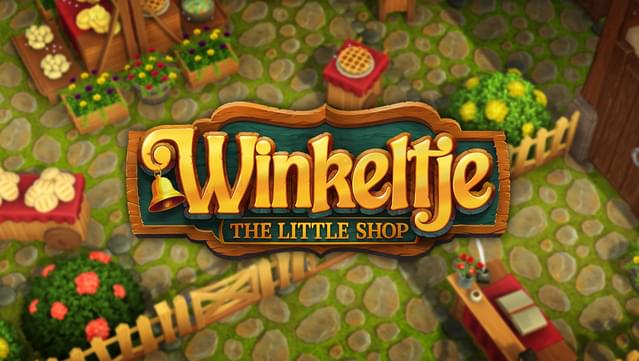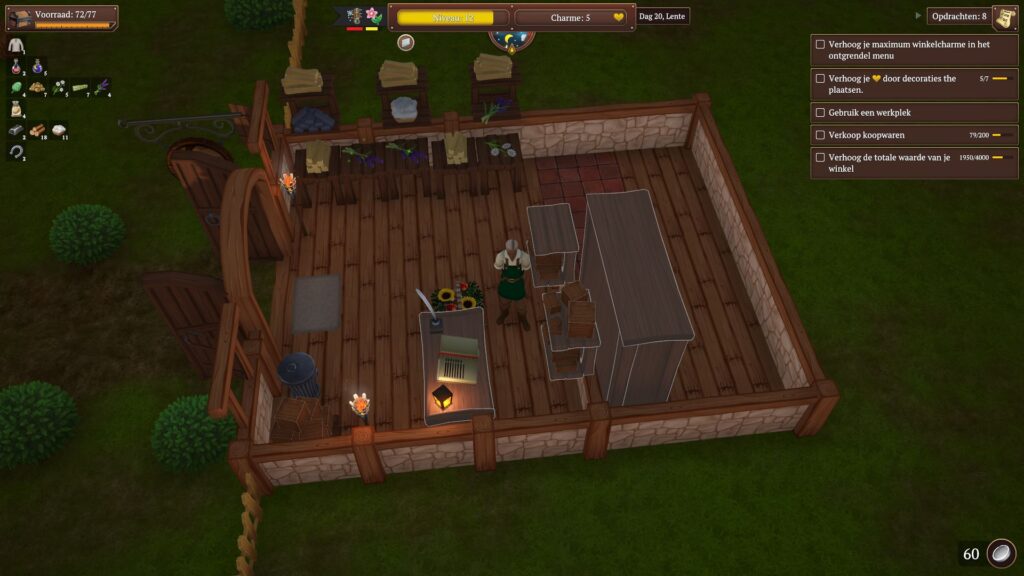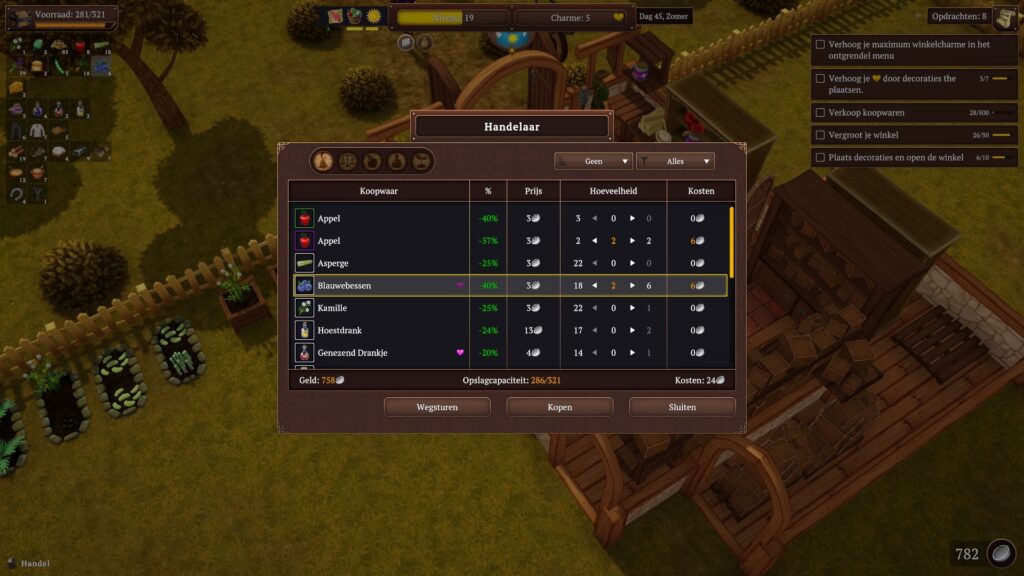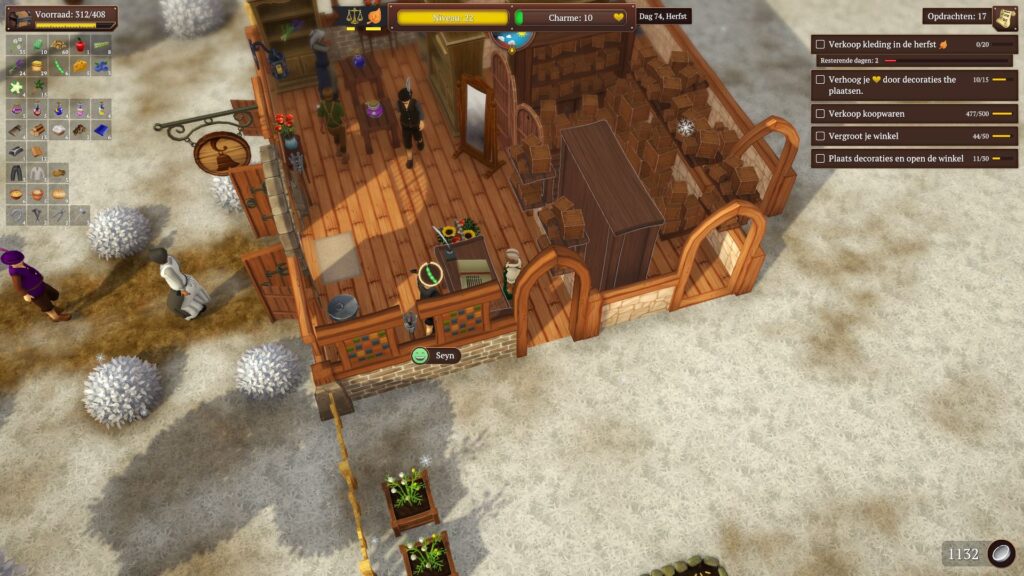
Developer: SassyBot Studio
Publisher: SassyBot Studio
Platform: Switch, PS4, Xbox One, PC
Tested on: PC
Winkeltje: The Little Shop – Review
Winkeltje: The Little Shop is a new game developed and published by SassyBot, a dutch indie game development studio. It is a medieval store builder in which you, as the name implies, have your own little shop that you expand during the game. It has a lot of different features that go into that simple concept and we are glad to be able to take a closer look at it today.
Story
There is not really a story in Winkeltje which is something we were missing in our playthrough. A storyline to distract from the grind that is upgrading your store could really improve the game.
Graphics
The visual aspect of Winkeltje: The Little Shop is everything it should be. The game doesn’t look hyperrealistic or super detailed but it looks nice enough to really make you want to unlock more things to make your shop look great. The many customization options and personalization allow for some great combinations, and in the hands of a creative person with enough time to unlock all the decorations, this game can look amazing.
Sound
The sound effects in this game are basic but that isn’t necessarily a bad thing. The music as well is nothing to be amazed by. There is little variation in the music and in combination with it being a grindy, repetitive game, it can get too monotone after a while. We found that after a while the game is best enjoyed with a podcast or a personal playlist in the background. This does not mean that we found the game’s sound design to be bad. The sound in Winkeltje is quite solid, it simply lacks variation for the many hours of repetitive tasks you’ll have to go through.
Gameplay
Winkeltje: The Little Shop is a medieval store builder. You start by owning a small store that you slowly upgrade by using one simple concept: buying low and selling high. You start by only being able to sell a few basic items such as apples and wood. As you level up, you unlock more items to sell, and customers will start asking for specific items. For that reason, it is very important to manage your inventory to be able to serve your customers what it is that they’re looking for. The main gameplay loop is split into two parts. You have the day where you open your store and customers come in to buy your products and you’ll have the night in which you prepare for re-opening your store by upgrading your store in multiple ways and planning to re-stock products that are sold out.
A few times per in-game day a special vendor arrives in your shop to sell you a small selection of items at a special discount. To optimize profits you should be buying from that vendor, but this is made challenging by the limited inventory space. Balancing having enough of all the different products with the limited inventory space can be a real puzzle. You can upgrade your inventory by placing storage pallets so you can slowly accumulate enough storage for everything you need. Managing your inventory as more and more different items are unlocked by buying from special vendors is the biggest challenge at the beginning of the game. Luckily, you’ll soon find yourself able to upgrade your inventory capacity from the profits you earn. Even though this can be very challenging, it feels extremely rewarding once you are able to sell customers whatever it is they are looking for.
At a certain point, you are able to focus on other things than just buying from special vendors and maintaining an inventory. Once the barrage of new items slows down, you are able to start growing your own crops and crafting your own items. Instead of having to buy from vendors, you are able to completely self-sustain and produce everything yourself. This is what the mid-to-end game revolves around. Planting and gathering crops, crafting clothes, potions, etc. It is all about keeping that stream of products going while saving up enough coins to upgrade your store and make your store look better by buying and unlocking decorations. Decorating and expanding your store can take a very long time as it is very expensive to do so. That being said, if we look at some of the things that the community of Winkeltje created, we can’t be anything other than amazed. There are enough customization options to allow for many unique and creative shops to be created.
There are six different difficulty levels you can choose from when you make your new shop. Relaxed, easy, normal, hard, very hard, and creative. The difference between them is how much debt you have, how much storage you have, how cheap it is to buy items, and how much customers pay for them. Relaxed is the only difficulty where you have no debt whatsoever, which means you cannot lose the game, you simply grind to make your shop look nice. Creative is the same thing, but with no grinding. Everything is free, so you can just focus on making your shop look amazing. The other difficulties just change the four aforementioned aspects to make the game harder to play. In the ‘very hard’ difficulty, the debt is so high and profit so low that it actually seems impossible at first glance. This way the game also offers something for the truly dedicated.
Conclusion
Winkeltje does a lot of things right. It offers both a relaxing game that simply focuses on making you feel good and a challenging game where one small mistake has you start over from scratch. The many customization options on top of that allow for everyone’s creativity to shine. There is something to be liked by all sorts of players. The game can be grindy at times, but that is definitely not something unique in this genre and is not necessarily a bad thing. If you like these kinds of games or are just looking for something to play while listening to a podcast in the background, then Winkeltje is something we can recommend.
Winkeltje: The Little Shop - Review,









No Comments